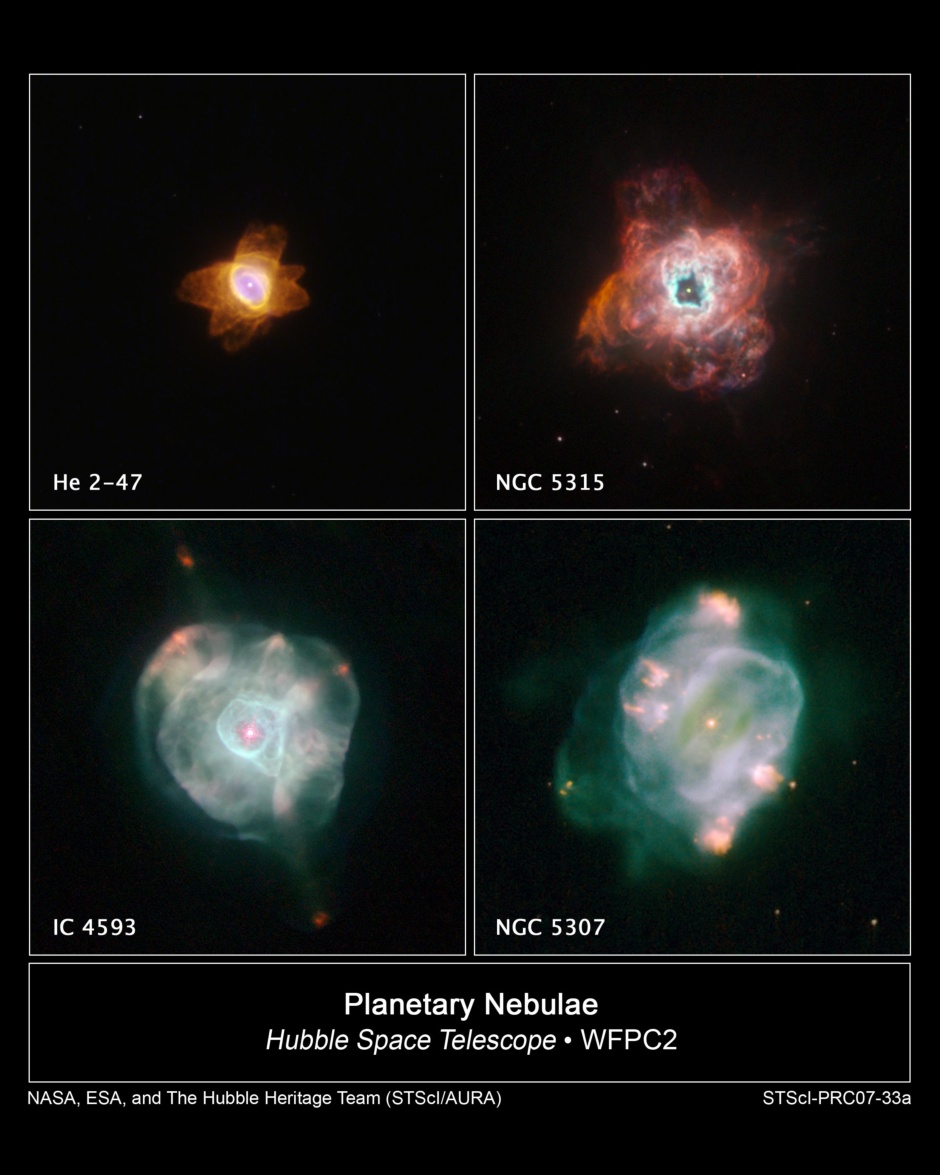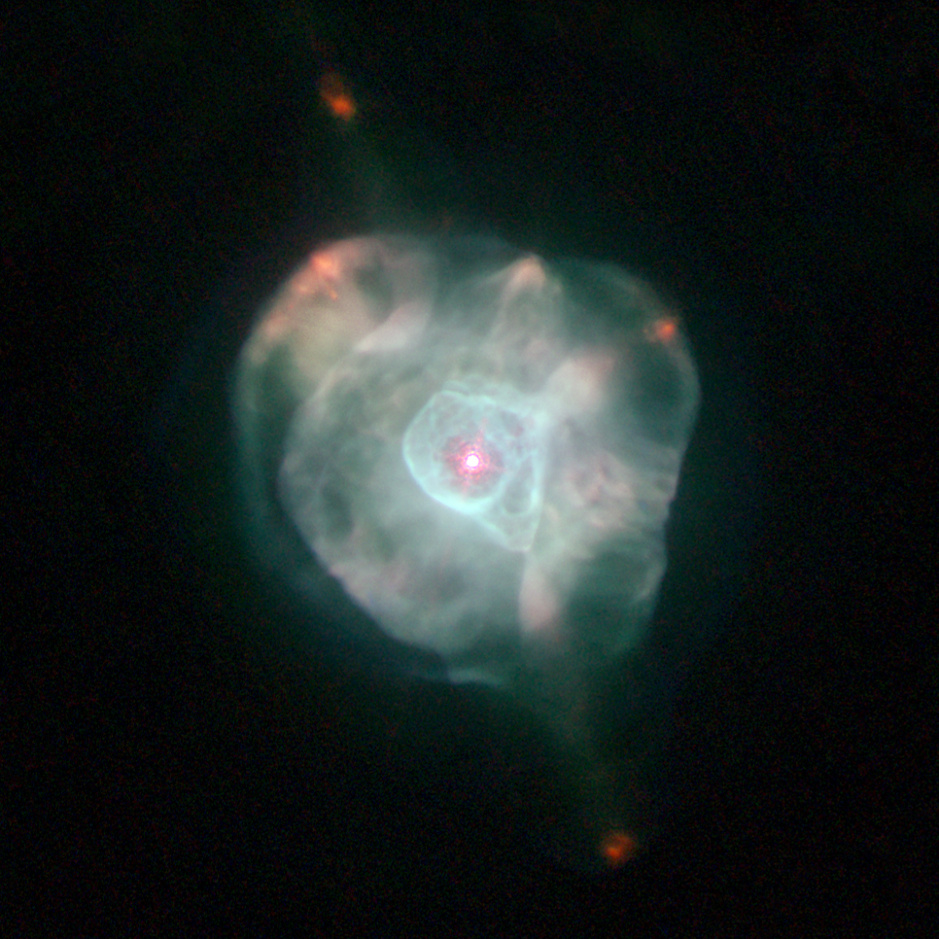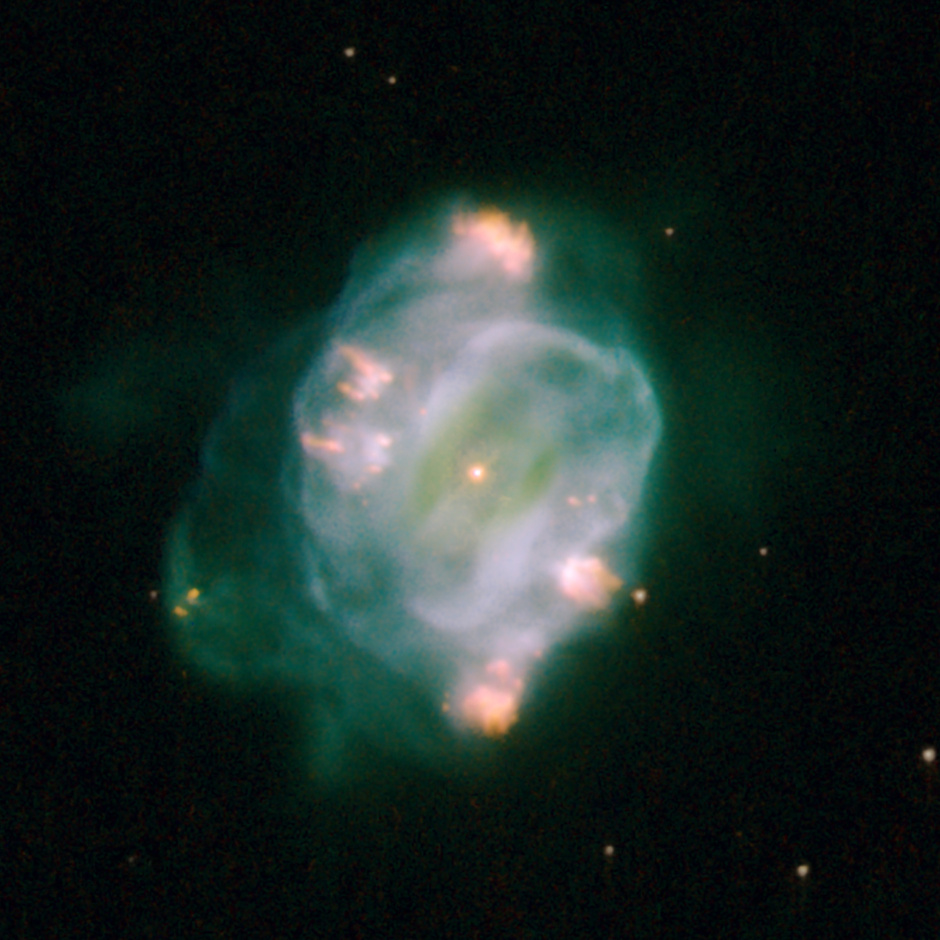허블 망원경이 포착한 이 사진들은
태양과 같은 별들이 종말을 맞이하는 시점에
맹렬하게 타오르는 가스의 분출양상을 보여준다.
행성상성운이라 불리우는 이들 가스구름들은
별의 일생 마지막 단계에서 그 구성물질들이 폭발하면서 우주공간으로 분출되어 만들어진다.
이 때 별의 잔해들로부터 나오는 자외선은 강열한 빛을 만들어낸다.
행성상성운은 100억년 정도의 수명을 가진 별들의
마지막 만년 정도에 해당하는 아주 짧은 순간에만 나타난다.
행성상성운이라는 명칭은 실제 '행성'과는 아무런 상관이 없는 이름이다.
이 명칭은 18세기경 작은 망원경을 통해 관측된 이들의 둥근 모습이
마치 행성을 닮았다고 하여 붙여진 이름이다.
허블 이미지는 행성상성운의 크기가 어떻게 팽창되고
온도가 어떻게 변하는지와 같은 행성상성운의 진화양상을 보여준다.
He 2-47로 명명된 이 행성상성운은 젊은 행성상성운으로,
크기가 작고 상대적으로 온도가 낮은 질소 가스로 구성되어 있다.
(허블 사진의 빨간색, 초록색, 파란색은 각각 질소, 수소, 산소이다.)
이 성운은 모양때문에 "불가사리별"이라는 별명이 붙어있다.
불가사리의 다리모양을 한 6개의 가스와 먼지구름들은
He 2-47이 최근 3개의 서로다른 방향으로 3번 폭발이 이루어졌음을 나타낸다.
매번마다 짝으로 해서 반대방향으로 별의 폭발이 일어난 것이다.
He 2-47은 용골자리 남쪽에 위치해 있으며 거리는 약 6600광년이다.
천년이상 가스구름이 확장되면서 성운의 크기는 점점 커지게 된다.
NGC 5315의 중심부에서 보이는바와 같이,
별로부터 나오는 강렬한 자외선은 가스중심으로 더더욱 깊숙이 들어가서
수소와 산소섬광을 더욱 두드러지게 보이게 만든다.
혼란스럽게 보이는 NGC 5315는 X모양의 구조를 보여준다.
이러한 형태는 별의 폭발로 인한 물질분출이 두 방향으로 이루어졌음을 나타낸다.
각각의 분출은 서로 직각으로 분출되었다.
NGC 5315는 컴퍼스자리 남쪽에 위치해 있으며 거리는 약 7000광년 (2.14kpc)이다.
IC 4593이나, NGC 5307과 같은 늙은 성운들은
거의 대부분이 수소와 산소로 나타나고 있으며 질소의 붉은 점들이 간간이보이게 된다.
IC 4593은 헤르쿨레스자리 북쪽에 위치해 있으며 거리는 약 7900광년 (2.42kpc)이다.
NGC 5307의 나선형 모양은 서로다른 방향으로 뻗어나가던 가스가
죽어가는 별의 진동에 영향을 받아 휘어지면서 만들어졌을 것이다.
NGC 5307은 센타우루스자리 남쪽에 위치하며 거리는 약 7900광년 (2.42kpc)이다.
이들 성운들은 모두 우리 은하에 위치해 있다.
이들 이미지들은 허블 광대역 카메라2에 의하여 2007년 2월에 촬영되었다.
* '허블사이트'의 게시물들은 허블공식 사이트 http://hubblesite.org 의 글들을 기반으로 약간의 편집을 거쳐 만들어집니다.
이 글은 2007년 9월 11일 발표된 뉴스입니다.
http://hubblesite.org/newscenter/archive/releases/2007/33/image/a/
원문>
The colorful, intricate shapes in these NASA Hubble Space Telescope images reveal how the glowing gas ejected by dying Sun-like stars evolves dramatically over time.
These gaseous clouds, called planetary nebulae, are created when stars in the last stages of life cast off their outer layers of material into space. Ultraviolet light from the remnant star makes the material glow. Planetary nebulae last for only 10,000 years, a fleeting episode in the 10-billion-year lifespan of Sun-like stars.
The name planetary nebula has nothing to do with planets. They got their name because their round shapes resembled planets when seen through the small telescopes of the eighteenth century.
The Hubble images show the evolution of planetary nebulae, revealing how they expand in size and change temperature over time. A young planetary nebula, such as He 2-47, at top, left, for example, is small and is dominated by relatively cool, glowing nitrogen gas. In the Hubble images, the red, green, and blue colors represent light emitted by nitrogen, hydrogen, and oxygen, respectively.
Over thousands of years, the clouds of gas expand away and the nebulae become larger. Energetic ultraviolet light from the star penetrates more deeply into the gas, causing the hydrogen and oxygen to glow more prominently, as seen near the center of NGC 5315. In the older nebulae, such as IC 4593, at bottom, left, and NGC 5307, at bottom, right, hydrogen and oxygen appear more extended in these regions, and red knots of nitrogen are still visible.
These four nebulae all lie in our Milky Way Galaxy. Their distances from Earth are all roughly the same, about 7,000 light-years. The snapshots were taken with Hubble's Wide Field Planetary Camera 2 in February 2007. Like snowflakes, planetary nebulae show a wide variety of shapes, indicative of the complex processes that occur at the end of stellar life.
He 2-47, at top, left, is dubbed the "starfish" because of its shape. The six lobes of gas and dust, which resemble the legs of a starfish, suggest that He 2-47 puffed off material at least three times in three different directions. Each time, the star fired off a narrow pair of opposite jets of gas. He 2-47 is in the southern constellation Carina.
NGC 5315, the chaotic-looking nebula at top, right, reveals an x-shaped structure. This shape suggests that the star ejected material in two different outbursts in two distinct directions. Each outburst unleashed a pair of diametrically opposed outflows. NGC 5315 lies in the southern constellation Circinus.
IC 4593, at bottom, left, is in the northern constellation Hercules.
NGC 5307, at bottom, right, displays a spiral pattern, which may have been caused by the dying star wobbling as it expelled jets of gas in different directions. NGC 5307 resides in the southern constellation Centaurus.
For more information, contact:
Donna Weaver/Ray Villard
Space Telescope Science Institute, Baltimore, Md.
410-338-4493/4514
dweaver@stsci.edu
villard@stsci.edu
Keith Noll
Space Telescope Science Institute, Baltimore, Md.
410-338-1828
noll@stsci.edu
Object Names: He 2-47, NGC 5315, IC 4593, NGC 5307
Image Type: Astronomical
Credit: NASA, ESA, and The Hubble Heritage Team (STScI/AURA)
'3. 천문뉴스 > 허블사이트' 카테고리의 다른 글
| 별들의 요람 NGC 4449 (0) | 2007.09.19 |
|---|---|
| 젊은 별과 암석부스러기 Disk (0) | 2007.09.19 |
| 허블이 촬영한 깊은 우주 (0) | 2007.09.08 |
| 베일 성운의 초신성 폭발 잔해 (0) | 2007.09.02 |
| 천왕성의 링 (0) | 2007.09.02 |




